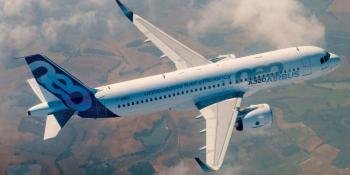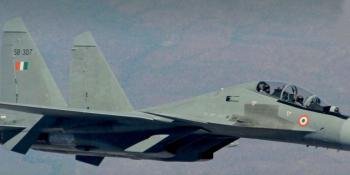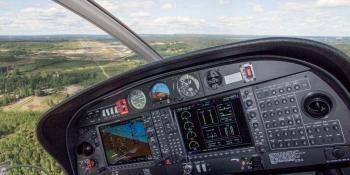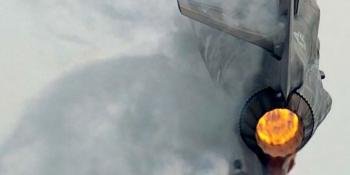COMMERCIAL
Chris Kjelgaard looks at how FIGAS, the government-owned airline of the Falkland Islands, is updating its fleet to cope with increasing traff c demand driven by tourism
FALKLAND ISLANDS GOVERNMENT AIR SERVICE

Celebrating its 70th birthday this year, Falkland Islands Government Air Service (FIGAS) has long provided vital lifeline air services throughout the Falklands archipelago, which lies some 300 miles off the southeast coast of South America. Formed in 1948 with two single-engine Auster Mk5s specifically to help reduce the isolation of people living in remote areas of the Falklands – which are made up of two large islands, East and West Falkland, and 776 smaller islands – FIGAS flew its first passenger flight, which was also its first air ambulance flight, that December. FIGAS performed that historic flight to carry from the North Arm settlement on East Falkland to Stanley, the capital of the Falkland Islands and the territory’s largest community, a small child who required urgent medical attention.
For much of the next three decades, starting in 1953, FIGAS came to rely on the rugged de Havilland Canada DHC-2 Beaver as its main workhorse. At any one time operating no more than two Beavers, both equipped with floats and operated to and from water, FIGAS relied upon the Beaver as its only fleet type from 1956 until 1979. At that point a FIGAS review committee decided a twin-engine aircraft type able to operate from grass strips would be more economical for to operate and easier for FIGAS to maintain because the aircraft would be less prone to salt-water corrosion.
FIGAS chose the Britten-Norman BN2 Islander as the most suitable type to replace the Beaver and took delivery of its first Islander in 1979, the aircraft arriving at Port Stanley Airport – which has remained FIGAS’ base to this day – shortly after the airport was opened. Unfortunately for FIGAS that first Islander, which was registered VP-FAY, was destroyed during the Falklands War in 1982 and for several months the carrier reverted to operating a single Beaver floatplane, which it received in December 1982.
However, during the following year FIGAS took delivery of two new BN2 Islanders and in 1985 it ended Beaver operations permanently. Then, in January 1986, FIGAS took delivery of a third new Islander, a BN2B-26 registered VP-FBD. Although FIGAS subsequently retired the two 1983-built Islanders it had been operating, VP-FBD remains in passenger service today as FIGAS’ oldest, highest-time and highest-cycle aircraft.

FIGAS added another new BN2B-26, VPFBM, in May 1989 and in July 1990 it took delivery of two more new BN2B-26s, VP-FBN and VP-FBO. The carrier initially operated both of the 1990-built aircraft on fisheries patrol missions and had them modified accordingly, according to Kurt Whitney, FIGAS’ quality manager for engineering and operations. However, by 2010 FIGAS had removed the patrol-mission modifications from VP-FBN and dedicated the aircraft to passenger operations.
VP-FBO remains primarily dedicated to fisheries patrol operations, but Whitney told AIR International that no more than 30 minutes’ work is needed to make the aircraft available for passenger flights. He said FIGAS uses VP-FBO from time to time to operate scenic flights for tourists. Tourists to the Falkland Islands arrive on cruise ships berthing at Port Stanley, or they land at RAF Mount Pleasant on scheduled LAN A320 flights from Punta Arenas in Chile or Air Tanker A330 MRTT passenger charter flights from RAF Brize Norton in the UK. RAF Mount Pleasant – at which a detachment of four No.1435 Flight Typhoon FGR4s is based – opened in May 1985 and has an 8,497-foot runway which is the only runway in the islands capable of handling large jets.


In March 1992 FIGAS received another new BN2B-26 Islander, VP-FBR, which together with VP-FBD, VP-FBM, VP-FBN and VP-FBO remains in its current fiveaircraft, all-Islander fleet. As with all its other Islanders except VP-FBO, VP-FBR is dedicated to passenger service and to air ambulance flying when required. Converting any given Islander in the FIGAS fleet from passenger configuration to an air ambulance takes about 20 minutes, according to Whitney.
FIGAS operations and traff c growth
While FIGAS begins operating flights at 08:00hrs each day and during the Southern Hemisphere summer months from December through February keeps flying until about 20:00hrs, it does not fly at night, said Whitney. Any air ambulance flights required at night are performed by Sikorsky S-92 helicopters based at Stanley for rescue and oil rig support flights and operated by Bristow Helicopters, or by Leonardo AW189s based at RAF Mount Pleasant for search and rescue operations and operated by British International Helicopters.
To provide its passenger services (some of which also carry cargo), FIGAS operates from Port Stanley and Mount Pleasant – the only two asphalt runways in the Falkland Islands – to more than 30 grass airstrips throughout the archipelago, many located at farms or on islands which have selfcatering lodges for tourists who want to experience close up the natural beauty of the islands and their unique flora and fauna. Most FIGAS flights are of very short duration, but some are much longer – for instance, the flight between Stanley and New Island at the far western edge of the archipelago takes about 90 minutes.

All of the revenue passenger flights FIGAS operates are air taxi-type charters, many carrying Falkland Island residents between the farms or small island communities in which they live and Stanley. Although each FIGAS Islander can carry up to nine passengers (including one in the co-pilot’s seat in the cockpit: each flight is operated by a single pilot), the allowable passenger payload for a flight can vary “down to two or three passengers” depending on the airstrip from which the flight is operating and the condition of the strip, said Whitney. Because the Falkland Islands are often subject to strong winds – the islands are devoid of trees, much of the vegetation consisting of wind-resistant dwarf shrubs – many FIGAS flights are subject to strong crosswinds on take-off and landing.
However, most FIGAS employees today – including all its pilots – are native Falkland Islanders, so they are very familiar with the weather conditions the islands experience. Whitney said FIGAS recently sent its first female pilot (a Falkland Islands native) overseas for commercial pilot training and was interviewing two more candidates with the aim of sending another pilot to be trained.
The airline also carries military personnel and their families, and civilian contractors, between Stanley and Mount Pleasant. On these flights, each Islander flight can carry a full complement of nine passengers. But FIGAS’ fastest-growing demand is for scenic flights between East Falkland and West Falkland or to the outer islands. Many of these flights offer out-and-return ‘round robin’ stand-by seats marketed to tourists by FIGAS, which also operates whole-aircraft charters for tourists.
Tourism-related passenger traff c “is picking up quite a bit year by year,” said Whitney. Although for government-imposed reasons he wasn’t allowed to give AIR International precise FIGAS passenger numbers and traff c growth rates for this year or for the past few years, a recent Britten-Norman press release quoted Whitney as saying that in last year’s winter-to-summer season FIGAS carried over 1,000 more passengers than it had in the same period the previous year.
The continuing growth FIGAS is experiencing in tourism-related demand for its passenger flights has persuaded the airline to undertake a major upgrade eff ort to ensure that its fleet continues to operate reliably throughout the foreseeable future. This growth has also led FIGAS to seek permission from the Legislative Assembly of the Falkland Islands (i.e., the Falkland Islands Government) to increase the number of aircraft it operates.
FIGAS’ cockpit-upgrade initiative
A stand-alone entity until seven years ago but then brought under the oversight of the Falkland Islands Government Aviation Services department, which also oversees the Stanley control tower operation and all aerodrome fire services throughout the islands, FIGAS launched a competitive tender in 2016 for bids to upgrade the avionics and instrument panels in its five Islanders.
There were four compelling reasons why the upgrades were necessary, according to Whitney. First was that, FIGAS having operated the aircraft since new and the five Islanders ranging in age from 26 to 32, “as time has gone on it is getting harder and harder to get [replacement analogue] instruments, because of obsolescence,” he said.



Second was that for the requirements of air traff c management surveillance – which in the Falkland Islands is mainly under the control of the UK Ministry of Defence – and other operational reasons, FIGAS wanted each Islander to have GPS navigational capability and ADS-B Out 1090ES transponders. This was so that the pilot on each flight could know what the aircraft’s three-dimensional position was with a high degree of accuracy at any point during the flight and at all times air traff c control could see each aircraft’s position, height, airspeed and ground speed, identity, track, heading and route to within a few seconds of flying time.
Third was that because the five aircraft ranged in age, the cockpit layout in each aircraft was different. This was particularly the case for VP-FBD and VP-FBM, which as the two oldest aircraft in the fleet had “considerably different engine instrument panels” from the other three Islanders.
The five different instrument panel layouts meant there was no cockpit commonality in the fleet, making each Islander pilot’s job more difficult.
Fourth was the fact that after reviewing its fleet-upgrade options, FIGAS decided it could continue to operate its elderly fleet of Islanders – which do not have defined airframe life limits – reliably for another decade before replacing them with another type, as long as the cockpits of the aircraft were modernised. FIGAS decided that what was needed was a common cockpit layout with current-generation digital instruments and an electronic engine instrument display.
Following the tender process, FIGAS selected Islander manufacturer Britten- Norman in March 2017 to perform the cockpit upgrades, because its bid “offered the best value”, according to Whitney. FIGAS asked Britten-Norman to purchase in one batch identical instrument instruments, panels and displays to ensure that the cockpit of each Islander could be made identical – or very nearly so, in the case of the fisheries patrol aircraft VP-FBO, which FIGAS additionally wanted to have weather radar and a marineband radio.

Additionally, as the first two aircraft to enter the fleet, VP-FBD and VP-FBM had 50-amp generators, but the three younger aircraft had been outfitted since new with 70-amp generators. The new cockpits’ digital instruments and displays required a robust electrical power supply, so FIGAS awarded a separate contract to Britten-Norman to replace the original generators in the two oldest aircraft with 70-amp units.
FIGAS selected for the five aircraft the Garmin G600 electronic display system, along with a GTN 650/750 GPS navigation and communications unit, a GTX 335R remote-mounted transponder with ADS-B Out capability and an electronic engineinstrument display. Additionally, FIGAS selected the GWX 70 weather radar for the fisheries patrol aircraft VP-FBO.
The cockpit-upgrade installations began last autumn, FIGAS’ own engineers performing the work at the carrier’s Port Stanley Airport maintenance base under the supervision of two engineers seconded by Britten-Norman to oversee and approve the work. During the work, each aircraft is also being stripped out, re-fit, flight-tested and certificated. The first aircraft to be given the new cockpit was VP-FBO, the specialmission aircraft, Britten-Norman signing off on the work on December 7.
VP-FBD, the eldest sibling in the fleet, was inducted for the cockpit upgrade, generator upgrade and aircraft re-fit work in January and VP-FBM, the second-eldest, will also receive the upgrades this year. FIGAS and Britten-Norman expect to complete the cockpit upgrades in 2019 with the inductions of VP-FBR and VP-FBN.
FIGAS seeks another Islander
Because its tourism-related passenger traff c is continuing to grow “quite dramatically” and “we’re actually getting to the struggle point and definitely need another airframe to meet the demand”, according to Whitney, FIGAS has asked the Members of the Falkland Islands Legislative Assembly to decide if it can purchase another, brand-new BN2B-26 Islander, an airframe which is now on Britten- Norman’s production line.
Should the decision to purchase be made, FIGAS will gain a decade of operational leeway before renewing its fleet. During that time it will also be able to keep operating reliably its five existing Islanders. However, at some point within the decade FIGAS will look to begin replacing its older Islanders with another aircraft type offering about the same capacity as the Islander, said Whitney.
That might seem counter-intuitive: one might think that if FIGAS keeps experiencing growing traff c demand, a larger aircraft type – say, a 19-seater with STOL, rough-field capability similar to that of the Islander, such as the rugged Viking Twin Otter 400 – potentially could make sense as an Islander replacement.
However, another consideration rules out that possibility, said Whitney. At most or all of the grass airstrips FIGAS serves, the local farmers or landowners operate the aerodrome fire services themselves, on a part-time, volunteer basis. But if FIGAS were to switch to a larger aircraft type carrying more passengers, fire regulations would require the fire services at those remote strips to be equipped with larger fire appliances, to be staff ed with fully trained, full-time firefighting staff and for the fire services to be re-certificated every three years. This would be prohibitively expensive for the Falkland Islands, which has a resident population of just over 3,000 people.
FIGAS has looked at the BN2T turboprop version of the Islander, but the carrier’s highcycle, short-flight operations don’t suit turbine operations, said Whitney, adding: “What would be really ideal would be for Britten-Norman to re-engine the Islander with more power, for more performance and payload.”
Britten-Norman might be considering such a move. But FIGAS has already performed considerable due diligence on the Tecnam P2012 as a potential Islander replacement and remains interested in the type. To that end, said Whitney, FIGAS “will be monitoring” US carrier Cape Air’s operations with 20 P2012s it has ordered – Cape Air eventually hopes to operate 100 – to see if the P2012 could be a suitable fit for FIGAS’ exacting operations.





